The art of engraving dates back to the dawn of human history. Archeologists have unearthed engraved stones from the Serengeti Plains of Africa carved some 500,000 years ago. Since that time, as civilizations rose and fell, artisans have used “push engraving” (using a hand tool to carve out material) or “chase engraving” (using a hammer or other tool to strike the carving tool) to add value to objects, ranging from the sacred to the profane. Specifically, firearms . . .
Europeans initially viewed firearms as mystical not-say-demonic devices. Thanks to their undeniable beauty and slowly improving utility, firearms became more commonplace through the 16th and 17th centuries. Even so, they remained handmade one-offs, reserved for nobility. As such, firearms were subject to the demands of fashion. As Kristen Hoff writes in the The History of Engraving . . .
The “Golden Age” of gun engraving is usually considered to be the second half of the 1800s. During this period, nearly all gun manufacturers created elegantly engraved firearms for their wealthier customers. American firearms engraving came into its own during this era, as it evolved into a large, flowing scrollwork. Firearms engraving continued into the 20th century, when it began to decline.
With the invention of laser engraving, the market for labor-intensive hand engraving has continued to diminish. While there are still superb artisans plying their trade, economic necessity tends to restrict their work to the highest of high-end shotguns and rifles. As their predecessors have for hundreds of years, they painstakingly hand craft traditional hunting scenes and scrollwork for well-heeled collectors.
When a new medium replaces an old one — such as radio replacing newspapers — it frees the old medium to reinvent itself. This truism applies to firearms engraving. As the market for traditional firearms engraving has faded, a new breed of nontraditional firearms engravers has emerged, epitomized by the master works of Otto Carter.
In 1981, Otto Carter was an art student at Texas’ Abilene Christian University. One day, a friend showed Carter his recently purchased 1873 Colt single action revolver and knife set commemorating the Abilene Centennial [above]. Weldon Lister engraved the gun using 1800’s-style scrollwork. Carter was entranced.
After earning his Bachelor of Fine Arts degree, Carter continued as a sign painter at Ellison Edwards Sign Co. But he never forgot the beauty and artistry of that Colt. In 2002, further inspired by James B. Meek’s The Art of Engraving, Carter attended a course led by Firearms Guild of America Master Engraver Mike Dubber. The seed planted by the Colt took root.
“Engraving has a steep learning curve,” Carter says, “It takes years of patient perseverance to master.” Carter applied his growing talents to a range of objects, including motorcycle parts, watches, jewelry and firearms. After thousands of hours of dedicated labor, Otto joined the Guild and earned the title Master Engraver.
His new career began with traditional scrollwork. “You can’t play jazz without first learning music theory,” Carter says. His journey into non-traditional firearms engraving began with a customer’s request for a Celtic design on a cherished revolver. The commission opened-up a world of possibilities. Carter began engraving a variety of non-traditional designs on firearms; such as snake-skins, cattle brands, tribal symbols and skulls and flames (inspired by his work for Big Daddy Roth).
Carter’s firearms engraving reached new heights with two recent pieces. In 2014, he engraved a Bond Arms Derringer in the Aztec style, complete with a matching ring. In 2015, Carter completed a H.R. Geiger-inspired Dan Wesson Valor 1911 (above). In 2016, Pennsylvania 1911 manufacturer Cabot Guns saw Carter’s Geiger gun and approached the engraver with an open-ended commission.
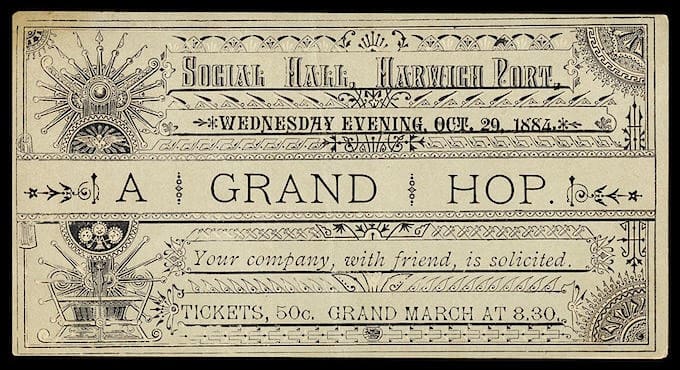
Carter agreed to engrave the Cabot 1911 using a little known design language born in Victorian era Britain. “I’ve been fascinated by the Aesthetic Movement for years,” Carter says. “It doesn’t have the rhythmic flowing patterns of traditional scrollwork. It features a chaotic composition, with large fields broken up by geometric brackets and banners separating different pattern motifs.”
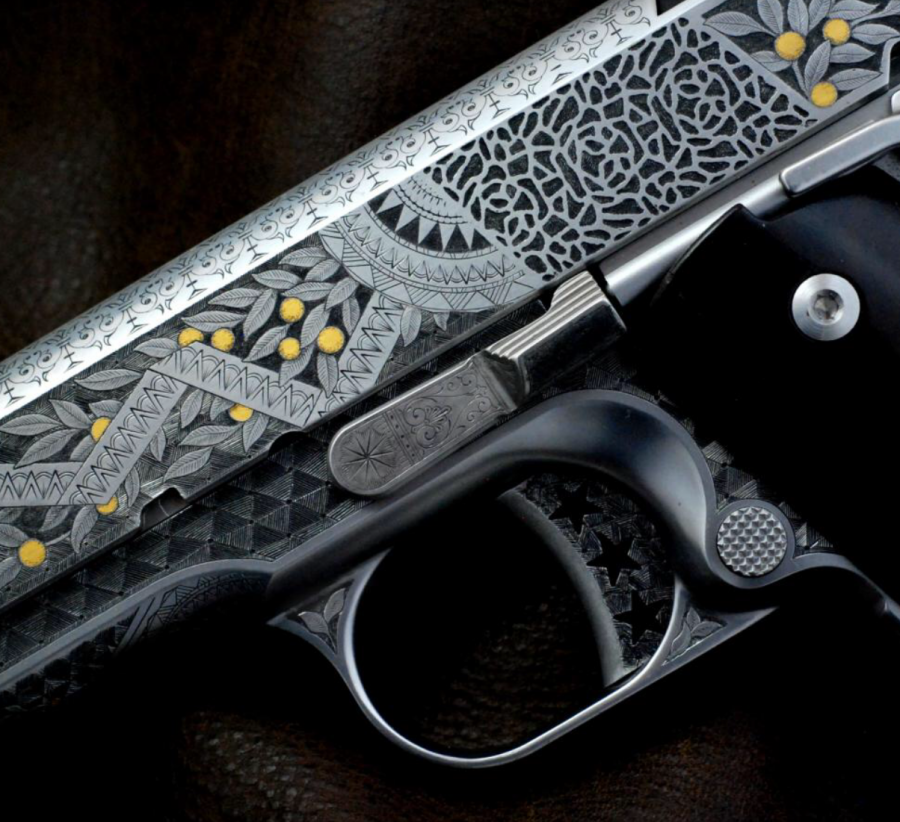
“The lack of obvious continuity is a radical approach compared to anything in traditional engraving,” Carter asserts. “But I think it’s fascinating; informed by Asian, Moorish, Italian and other cultural influences, drawn from the furthest reaches of the British Empire.”
Christened “Pandemonium,” the Carter-engraved Cabot 1911 is available for sale by auction through Cabot Guns.

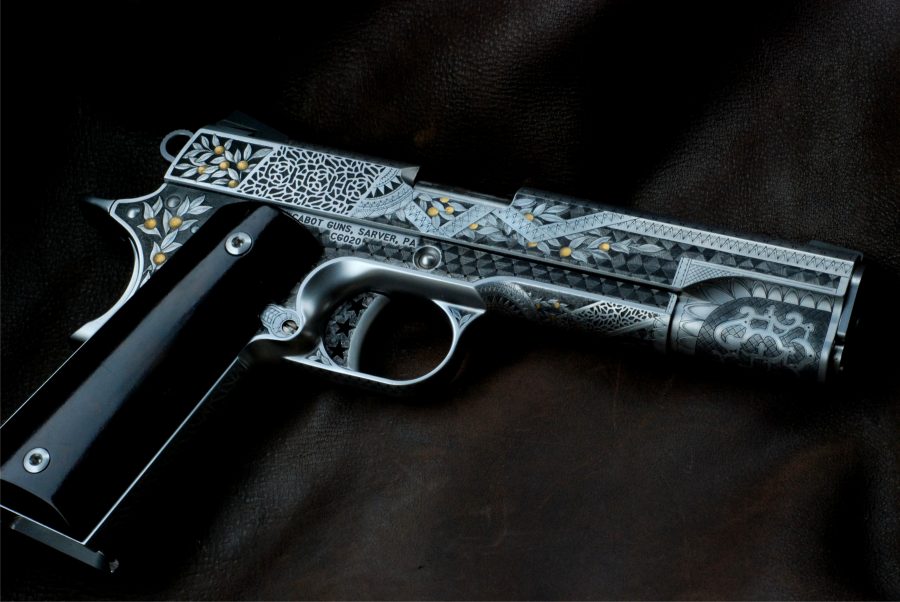
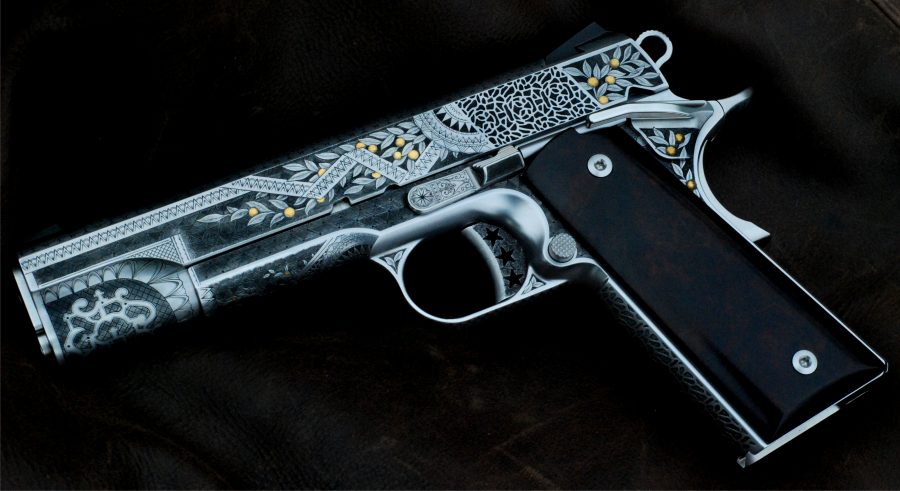

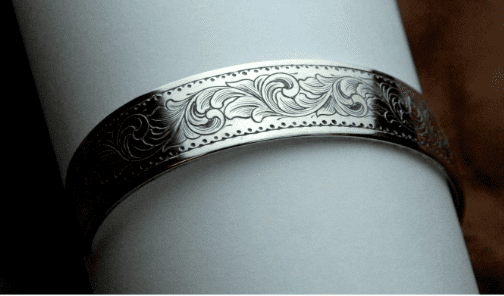
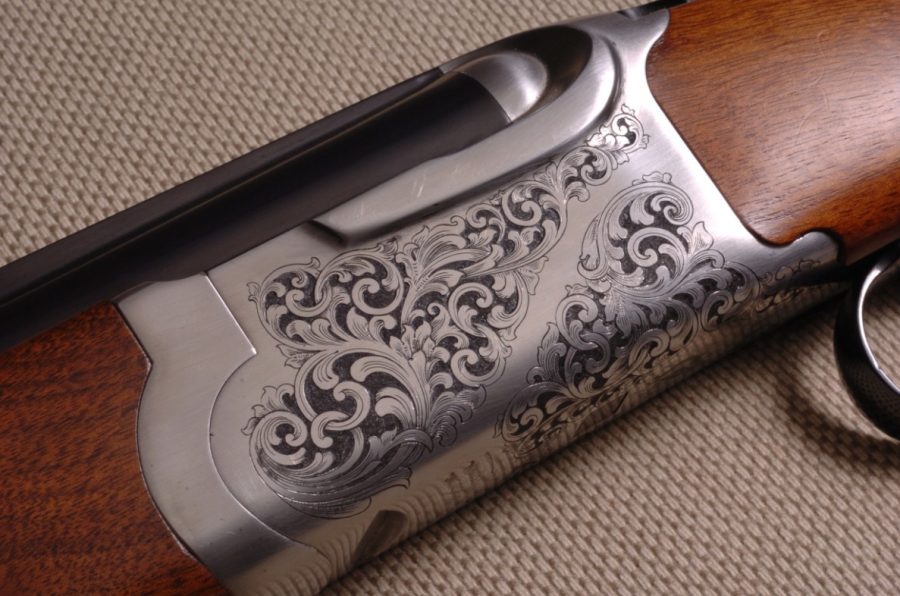
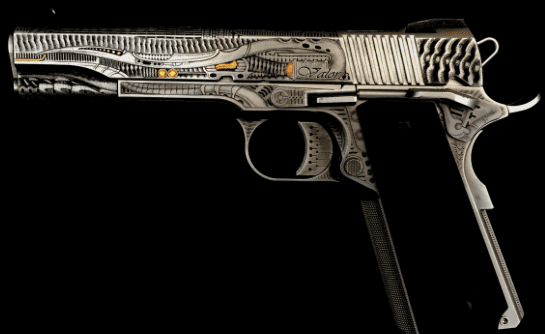



Well that’s real nice-does it even run? And would you shoot it?
Not a fan of engraved guns myself, but that is some beautiful work.
The problem I have with engraved guns is that they are too fvkin valuable to shoot. My piddly rugers and glocks can attest, they do not live a easy life in the safe or closet. They get dropped, damp, minor surface rust sometimes, scratches and dents.
The above pistol? Handled with curator gloves only, and fired less than a dozen sessions in its multi century life… Probably never properly broken in even, if such a thing exists for such a fine piece of art. And no idiot scratches.
Exactly the opposite. They are too valuable not to shoot. Powerful tools should be beautiful, and they should be used.
I’d shoot it until my hands bled.
Awesome!
Breathtaking. Makes me want to pee a little.
Go ahead, let a little out. No one’s looking. 😉
Hmm, I suppose I am a member of that proletariat thing after all. I am getting some class envy going:-|
Outstanding work. Master indeed…
WOW. Tattoo’s for guns by a Master Engraver. Can the poor folk buy a poster of it?
Not my style, but it does showcase his incredible skill. Though, I can’t believe ya’ll went to all that trouble but didn’t replace that cheeseball trigger. Those Wonder Woman stars really don’t work with the engraving style at all.
All the beautiful work… brought down by the choice of grip screws.
Sigh.
That, by far, is the easiest to correct if so wished…
Yes, the screws are sadly pedestrian and completely incongruous to the ethos of the project. Seriously, what’s up with that? Still, the rest of the work is absolutely transcendent.
Beautiful work.
Not at all to my tastes, but I highly admire the artistry and artist.
Incredible work.
Brought down by the choice of gun.
Otto
Your obvious increased master of this fine art continues to evolve and it is a treat to witness this evolution as well as knowing I have a great example of your work as an avid fan.
Kudos to a master!…You will find your place in history as an innovative contributor to the engraving medium.
R Beverly
So, TTAG owns it, but Cabot is handling its auction?
(And, radio didn’t replace newsprint, the internet executed newspapers.)
Since TTAG didn’t officially respond I have a theory. TTAG doesn’t have an FFL, and this auction will probably bring a profit, so to avoid breaking the law it would be easier for Cabot to hold the gun and split proceeds with ttag.
Am I the only one that immediately thinks “coke-dealer?” The only thing missing is the Virgin Mary.
Or a banana republic strongman, oh, sorry, not in GOLD.
Yes. That’s a different style entirely.
I’m sorry, but there are to many different engraving styles in the Cabot. Looks almost like the engraver was trying to show all the different pattens that can be put on a 1911.
Sorry, not sorry?
It’s quite… Tarty. Inconsistent. It looks like he “tried too hard.”
I’m in awe of the craftsmanship that went into it. that 1911 is like a medieval cathedral: visually thrilling to the point of confusion, wonderful but not something i want to own.
Wait. I feel like TTAG has misled me. There’s some conflicting info here. Did you or did Cabot commission this gun? I feel a sense of great loss.
That 1911 is gorgeous
Comments are closed.